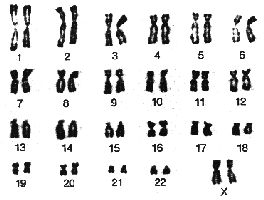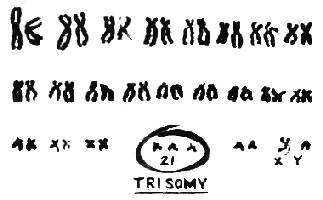This is what a normal set of chromosomes looks like. Note the 22 evenly paired
chromosomes plus the sex chromosomes. The XX means that this person is a female.
The test in which blood or skin samples are checked for the number and type of
chromosomes is called a karyotype, and the results look like this picture. 
Many errors can occur during cell division. In meiosis, the pairs of chromosomes are supposed to split up and go to different spots in the dividing cell; this event is called "disjunction." However, occasionally one pair doesn't divide, and the whole pair goes to one spot. This means that in the resulting cells, one will have 24 chromosomes and the other will have 22 chromosomes. This accident is called "nondisjunction." If a sperm or egg with an abnormal number of chromosomes merges with a normal mate, the resulting fertilized egg will have an abnormal number of chromosomes. In Down syndrome, 95% of all cases are caused by this event: one cell has two 21st chromosomes instead of one, so the resulting fertilized egg has three 21st chromosomes. Hence the scientific name, trisomy 21. Recent research has shown that in these cases, approximately 90% of the abnormal cells are the eggs. The cause of the nondisjunction error isn't known, but there is definitely connection with maternal age. Research is currently aimed at trying to determine the cause and timing of the nondisjunction event.
Here's the karyotype of a
male with trisomy 21: 


No comments:
Post a Comment